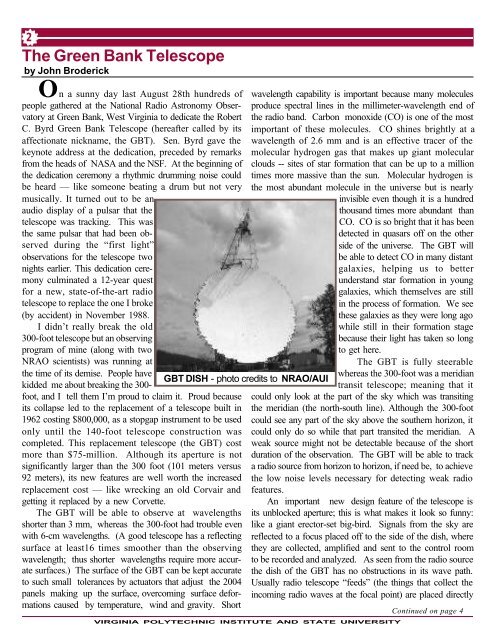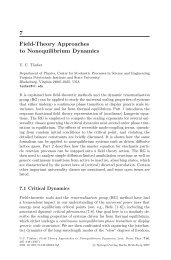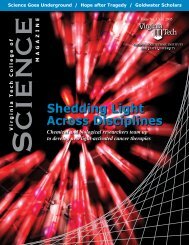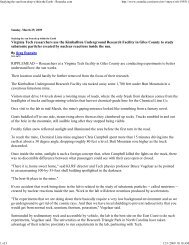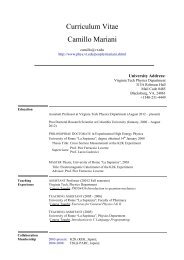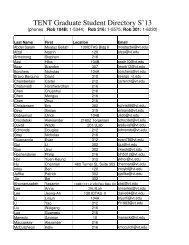Spring 2001 - Physics - Virginia Tech
Spring 2001 - Physics - Virginia Tech
Spring 2001 - Physics - Virginia Tech
You also want an ePaper? Increase the reach of your titles
YUMPU automatically turns print PDFs into web optimized ePapers that Google loves.
2<br />
The Green Bank Telescope<br />
by John Broderick<br />
GBT DISH - photo credits to NRAO/AUI<br />
On a sunny day last August 28th hundreds of<br />
people gathered at the National Radio Astronomy Observatory<br />
at Green Bank, West <strong>Virginia</strong> to dedicate the Robert<br />
C. Byrd Green Bank Telescope (hereafter called by its<br />
affectionate nickname, the GBT). Sen. Byrd gave the<br />
keynote address at the dedication, preceded by remarks<br />
from the heads of NASA and the NSF. At the beginning of<br />
the dedication ceremony a rhythmic drumming noise could<br />
be heard — like someone beating a drum but not very<br />
musically. It turned out to be an<br />
audio display of a pulsar that the<br />
telescope was tracking. This was<br />
the same pulsar that had been observed<br />
during the “first light”<br />
observations for the telescope two<br />
nights earlier. This dedication ceremony<br />
culminated a 12-year quest<br />
for a new, state-of-the-art radio<br />
telescope to replace the one I broke<br />
(by accident) in November 1988.<br />
I didn’t really break the old<br />
300-foot telescope but an observing<br />
program of mine (along with two<br />
NRAO scientists) was running at<br />
the time of its demise. People have<br />
kidded me about breaking the 300-<br />
foot, and I tell them I’m proud to claim it. Proud because<br />
its collapse led to the replacement of a telescope built in<br />
1962 costing $800,000, as a stopgap instrument to be used<br />
only until the 140-foot telescope construction was<br />
completed. This replacement telescope (the GBT) cost<br />
more than $75-million. Although its aperture is not<br />
significantly larger than the 300 foot (101 meters versus<br />
92 meters), its new features are well worth the increased<br />
replacement cost — like wrecking an old Corvair and<br />
getting it replaced by a new Corvette.<br />
The GBT will be able to observe at wavelengths<br />
shorter than 3 mm, whereas the 300-foot had trouble even<br />
with 6-cm wavelengths. (A good telescope has a reflecting<br />
surface at least16 times smoother than the observing<br />
wavelength; thus shorter wavelengths require more accur-<br />
ate surfaces.) The surface of the GBT can be kept accurate<br />
to such small tolerances by actuators that adjust the 2004<br />
panels making up the surface, overcoming surface deformations<br />
caused by temperature, wind and gravity. Short<br />
wavelength capability is important because many molecules<br />
produce spectral lines in the millimeter-wavelength end of<br />
the radio band. Carbon monoxide (CO) is one of the most<br />
important of these molecules. CO shines brightly at a<br />
wavelength of 2.6 mm and is an effective tracer of the<br />
molecular hydrogen gas that makes up giant molecular<br />
clouds -- sites of star formation that can be up to a million<br />
times more massive than the sun. Molecular hydrogen is<br />
the most abundant molecule in the universe but is nearly<br />
invisible even though it is a hundred<br />
thousand times more abundant than<br />
CO. CO is so bright that it has been<br />
detected in quasars off on the other<br />
side of the universe. The GBT will<br />
be able to detect CO in many distant<br />
galaxies, helping us to better<br />
understand star formation in young<br />
galaxies, which themselves are still<br />
in the process of formation. We see<br />
these galaxies as they were long ago<br />
while still in their formation stage<br />
because their light has taken so long<br />
to get here.<br />
The GBT is fully steerable<br />
whereas the 300-foot was a meridian<br />
transit telescope; meaning that it<br />
could only look at the part of the sky which was transiting<br />
the meridian (the north-south line). Although the 300-foot<br />
could see any part of the sky above the southern horizon, it<br />
could only do so while that part transited the meridian. A<br />
weak source might not be detectable because of the short<br />
duration of the observation. The GBT will be able to track<br />
a radio source from horizon to horizon, if need be, to achieve<br />
the low noise levels necessary for detecting weak radio<br />
features.<br />
An important new design feature of the telescope is<br />
its unblocked aperture; this is what makes it look so funny:<br />
like a giant erector-set big-bird. Signals from the sky are<br />
reflected to a focus placed off to the side of the dish, where<br />
they are collected, amplified and sent to the control room<br />
to be recorded and analyzed. As seen from the radio source<br />
the dish of the GBT has no obstructions in its wave path.<br />
Usually radio telescope “feeds” (the things that collect the<br />
incoming radio waves at the focal point) are placed directly<br />
VIRGINIA POLYTECHNIC INSTITUTE AND STATE UNIVERSITY<br />
Continued on page 4


